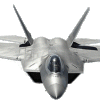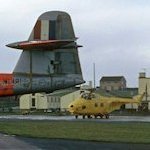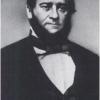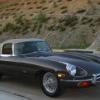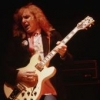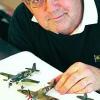Leaderboard
Popular Content
Showing content with the highest reputation on 20/01/18 in all areas
-
Another one that I have cleared off the shelf and finally finished. The lovely Airfix Supermarine Swift FR.5. Built as WK281 and flown by Flight Lieutenant Nigel Walpole, No. 79 Sqn, RAF Germany, Gutersloh, April 1956. I am almost reaching the stage where I can start building for myself and actually keep the model....!!! Cheers all, Phil31 points
-
This is Airfix's new Mustang finished as the mount of S/L Witold Tokuciewski of 303 Sqn. It was originally going to be in a RNZAF scheme but the black & yellow chequerboards on the fuselage sides disintegrated & curled up so, in the words of Wile E Coyote, back to the old drawing board. In the end I used Kagero's Mustangs over Europe, part 1, I also used Eduard's Zoom set for the cockpit. The kit goes together well but looks a little odd when you open the box due to the clever way it is engineered. This is my first attempt at NMF, I used AK Interactive paints which performed well although the black base was a bit patchy - but that was probably me. Next NMF aircraft will be the Eduard Mirage III. Any comments or criticisms welcome as always. Thanks for looking. Pete18 points
-
Hi, This is the Airfix 1/72 model of the Boulton Paul Defiant painted to represent the one flown by Squadron Leader Gatheral, officer commanding 256 Squadron in May 1941. The model was firstly sprayed grey followed by a loose spray coat of black by which I tried to recreate a slightly weathered look. The decals used were a combination of the kit decals, which to be honest were rather thick and didn't really seat correctly plus odds and sods from model decal sheets. Boulton Paul Defiant I, No N3500, coded JT-B, took of from its base at Squires Gate near Blackpool on the 8th May 1941 at 00.20 hours to carry out a night fighter sortie in the Liverpool area, the aircraft was piloted by Squadron Leader G. H. Gatheral the Squadron Commanding Officer and his air gunner was Flying Officer D. S. Wallen. A JU88 was spotted at 16,000 feet and the rear gunner opened fire from 100 yards registering hits on the fuselage being the wing root. Unfortunately the Defiant was hit in the glycol tank by return fire and the cockpit and turret filled with liquid and fumes. The pilot and gunner baled out and the aircraft crashed in flames near St. Helens. I hope you like it, Russ18 points
-
Hasegawa 1/48 plus Eduard, Master and CMK resin. Camo - Major Edward Rector - Flying Tigers - 76 F.S. 23 F.G. China july 1942.17 points
-
Hi all, here's my latest, the Airfix 1/48 Seafire MK XVII. good kit, just replaced the exhausts with resin once from Quickboost. I held back on the weathering as it is a trainer, and I assumed that they would be kept clean. (And my salt weathering didn't quite work out lol)14 points
-
Hi Here is my new finished kit with this reconnaissance fighter Dassault Mirage F1 CR from Special Hobby. This one is N°603 #33-NR of Escadron de Reconnaissance ER02.033 in 1988 in Chad. The shark mouth was added before going back to Reims AB, France. The vanilla/chocolate camouflage is typical of the Chad operations during the 1980s. She was loaded with two 1200 L fuel tanks, two Magic air-to-air missiles, a Phimat chaff dispenser under the starboard wing and a Barracuda ECM pod under the port wing. Patrick11 points
-
The new 1:72 MiG-21MF kit from KP Models which is a modified tooling of the original RV kit, with a few additions like a weapon load of AA-2, AA-8 air to air missiles and S-24 air to ground rockets and done away with the photo etch parts of the original RV kit. Build wise no real issues apart with me getting the main undercarriage a bit crooked, so the aircraft had a lean to one side, so had to break one leg off to reattach it. Basic scheme is from when the aircraft was operated by Egypt. Colours used are Model Master 2053 sand and Model Master 2054 brown on the upperside and Model Master 2038 grey on the underside. Decals are from DP Casper and went on without any issues. Decal sheet For those who don't want to look at the facebook link, the in progress photos are now also available in a Youtube video. Build Progress Photos MiG-21MF-54 by Ryan Hothersall, on Flickr MiG-21MF-55 by Ryan Hothersall, on Flickr MiG-21MF-56 by Ryan Hothersall, on Flickr MiG-21MF-57 by Ryan Hothersall, on Flickr MiG-21MF-58 by Ryan Hothersall, on Flickr11 points
-
I'm still deciding whether to do a 1/48 F-86A, E or F and have been looking at some unusual schemes for each. In the course of that I found some F-86A stuff which I gathered a couple of decades ago, and which I'm not going to use for the foreseeable future. So I thought I'd share it here and hope it will be of use/interest. Photos at end are from Dave Menard (first two); unknown newspaper (third one) and NASM (last pic). The Wright Patterson Flight Test Division Aerobatic Team The little-known aerobatic team formed within the Flight Test Division at Wright-Patterson AFB in Ohio was reportedly known as the Acrojests. Unfortunately the surviving members of the team, when interviewed, could not recall if the team even had a name and so the moniker must remain conjectural. The Flight Test Division reported directly to HQ Air Materiel Command and by 1949 was headed by Colonel Albert J Boyd, a noted test pilot and world air speed record holder (Lockheed P-80R, 623.74 mph on 19 June 1947). Beneath him, Boyd had a core of expert officers leading his various sections, with Maj Richard L Johnson in charge of the prestigious Fighter Section. Johnson had gained fame on 15 September 1948 when he too set a new world air speed record, this time in an F-86A (670.84 mph). It was Johnson who began thinking about an aerobatic team, selecting Capt HE Collins, 1/Lt John M Fitzpatrick and 1/Lt John J Knight to join him. According to Fitzpatrick, “In 1949, the Fighter Section, Flight Test Division was led by Dick Johnson, and he decided we would have an acrobatic team. It seemed then that at the drop of a hat we would have to put on a show. These shows involved flybys, two aircraft passes at a time and a lot of solo aerobatics.” It was Fitzpatrick who suggested in a March 1995 interview that the team name Acrojests had been put forward by Capt Raymond Popson (later killed in a Bell X-5); he thought it would be a light-hearted jibe at the similarly-named AcroJets team, which flew the Lockheed P-80 Shooting Star out of Williams AFB, Arizona. But whether the name went beyond a suggestion is not known: in view of the short life of Wright-Patterson’s team it is equally likely that no name was agreed upon. Dick Johnson also agreed with Popson’s suggestion, adding that, “We liked Acro-Jests [sic], at least I did anyway. We didn’t take ourselves too seriously.” The team would use Fighter Section F-86A and F-86E aircraft, a number of which had been assigned to the Flight Test Division from the autumn of 1948. Johnson would be team leader with Capt Collins on right wing, Lt Fitzpatrick on left wing and Lt Knight in slot. Practice sessions would be flexible, in part because it was often difficult to put together four Sabres at a time. However this did not deter the young team and according to John Fitzpatrick, “Because the mission of the Flight Test Division was to test new aircraft and modifications to existing ones, the Fighter Section had about two dozen aircraft representing every fighter in the inventory (and some that were not). These aircraft were usually modified for some test purpose [and] it was almost impossible to get four of the same kind available at the end of the work day when we practised. So we just used whatever was available. A typical “formation” might consist of an F-86 in the lead, an F-80 and an F-84 on the wings and an F-94 in the slot. And the next day it would be different”. The practice of using different aircraft types was probably unique for an aerobatic team. But it was not the only unusual aspect of the Wright-Patterson team: because of the need to maintain test integrity it was often the case that heavily-instrumented jets would be used for training sessions. One machine in particular posed issues, though it was still used by the team. John Fitzpatrick again, “We had an F-86A, actually the number one production aircraft [47-605] that had a special nose boom that protruded about 12 feet in front of the aircraft. It was being used for supersonic shock wave studies. Due to this inconvenience, when we used that bird, we never let anyone fly that aircraft in the slot position”. Aside from the more esoteric F-86A programmes such as the study of high-Mach shockwaves done by Richard Johnson in April 1950 (47-605), the Test Division also looked after more mundane Air Force test requirements. One of the latter was the evaluation of high-visibility paints, including fluorescent finishes perfected by Switzer Bros in nearby Cleveland. Perhaps inevitably these bright paint colours made their way on to the aerobatic team Sabres, though it is impossible to know if the aerobatic requirement drove the application of a paint scheme or if the team just happened to use F-86As that had been painted that way. But for whatever reason, the team aircraft carried extensive areas of ‘blaze orange’ paint, edged in a thin black line. Fuselage and fin areas were scalloped at their rear extremities while the wings and horizontal tail surfaces wore a linear ‘sunburst’ scheme. By 1950, Col Boyd had departed for Edwards AFB in California (where he set up the test pilots school) and was replaced as head of the Flight Test Division by Col FK Paul. It is thought that the team flew its first display that year, likely at a 21 May Open House held at Wright-Patt to mark the first Armed Forces Day commemoration. It has also been reported that the team performed at the 1951 National Air Races in Detroit, held on 18 and 19 August 1951, but contradicting that idea, John Fitzpatrick added that, “I’d say for a three to five month period we were active with the aerobatic team. We only did two or three actual shows that I can remember.” Dick Johnson recalled that a display was flown at Columbus, Ohio with a “3/4 team”, thus using three F-86A/Es rather than four. The display flown by the team was short and simple: John Fitzpatrick described the routine as, “Pretty basic. Formation take-off, fly-by, loops and rolls. We had just gotten started when it was ordered disbanded because there was to be only one “official” team”. That team was to be the Thunderbirds, though for a short period from 1956 thru 1959, the Colorado Air National Guard Minute Men team (flying F-86Fs) also gained official approval. This short-lived but colourful team was broken up sometime in 1950 (or possibly early 1951). Wright-Patterson Test Sabres used in the 1948 to 1951 period included XP-86s 45-59597 and 45-59599; F-86As 47-605, 47-607, 47-610, 47-611, 47-616, 47-619, 47-622, 47-633, 47-637, 48-170, 48-209, 48-295, 48-297, 48-298, 48-299, 48-303, 49-1014, 49-1075, 49-1135, 49-1144, 49-1170, 49-1172 and 49-1301; and F-86Es 50-588, 50-599, 50-605 and 50-606. Photos: F-86A-1 47-610 in the typical colour scheme worn by Acrojests F-86s: this machine served at Wright-Patterson from September 1948 as an EF-86A until it was written off in an accident on 21 August 1950. F-86A-5 49-1301, again in the 'team' scheme, but see text also. '301 was at Wright-Patterson from May 1951 (again designated EF-86A) until 3 November 1955. It survives, preserved at Maxwell AFB, Alabama. A poor but interesting scan from an unknown newspaper showing the team lifting off from Wright-Patterson circa 1950, and showing F-86E-1 50-588 in the lead position and F-86A-5 49-1135 on left wing. By looking at the common dates when both aircraft were assigned to Wright, the date must be between July and October 1951. Team leader of the Wright-Patterson Sabre team, Richard L Johnson, in the cockpit of F-86A-1 47-611 at the time of his world air speed record. '611 was another Wright-Patt Sabre. Final one: scrap view showing fluorescent paint scheme on wing and horizontal tail upper surfaces: from photographic evidence it seems likely that this scheme was not carried on the lower surfaces.10 points
-
All finished!Nice "little" build. Weathering finished off with AK Interactive pigments. Still getting the hang of them, but getting better. Mainly painted with Hataka Orange Line paints. Set off on a Coastal Kits Display Base. Ian G-2 by ian gaskell, on Flickr Ian G-2 by ian gaskell, on Flickr Ian G-2 by ian gaskell, on Flickr Ian G-2 by ian gaskell, on Flickr Ian G-2 by ian gaskell, on Flickr Ian G-2 by ian gaskell, on Flickr Ian G-2 by ian gaskell, on Flickr Ian G-2 by ian gaskell, on Flickr Ian G-2 by ian gaskell, on Flickr Ian G-2 by ian gaskell, on Flickr9 points
-
Hi Pals, I think I can finish this upgrade / "face wash" of this model. It has not been, let's say, very aggressive, because there is no metal element on it, of each and every one that can be added, only empty shells on top, although they are not attached. The fear to ruin the kit, has been able this time more, because the plastic is not too good (if to that we add the time that I have since it was built in the factory). Still, the products used to add, more than to simulate as before, the weathering, I think they have fulfilled their function. I would like to put it on a base, and add some figure, but for now, I can not, for lack of technique and space, maybe later ... Thanks for the comments about how to improve the finish. IHMO, I think it has deserved the effort, more than anything to see if at this time, I improved my technique somewhat, maybe, although I still have to continue persevering ... Thanks as usual for watch and comment, cheers mates Black background... With some picture effects...aka old pcitures or news images of the time Until next model....8 points
-
A kit that has been lurking in the stash for a while. Decent enough but I did have trouble lining up the engines and wings to the fuselage. And it needs huge amounts of weight in the nose. Finished in Vallejo Modelair silver and white. Quite a big aeroplane, almost the size of the Nimrod I finished a few weeks ago. 1. 2. 3. 4.8 points
-
Martin P6M-2 Seamaster http://village.photos/members/Frank-Bell/My-Photos/349542/IMGP3228 http://village.photos/members/Frank-Bell/My-Photos/349543/IMGP3229 Not a bad kit from Didier, one fuselage half just a little short shot in the nose, and two small pieces missing, but easily scratched. Not much flash, but as usual, a file, wet and dry and patience paid off. The fuselage halves are huge, and need to be glued a few inches at a time. Joints take a little filler, and the wing has some plastic strip inserted in the gap, but there is movement to allow for wing dihedral, which varied between the pre and production models. Biggest problem is the canopy, which has an incorrect framing moulded into it. Thankfully it is quite thick, which allowed me to sand it off, polish it, and mask it off correctly, and a dip in some Klear. Just over 50 parts in the airframe, and almost 100 more in the beaching trolley. More accurate and cheaper than the Anigrand version.8 points
-
Just saying - do we think it’s time to re-title this thread into something like ‘The ultimate Spey Phantom guru page’ and have it pinned by the mods?? This thread has morphed into something very special, especially by the excellent contributions of those who were there or those not very far from all the action. Certainly one to bookmark. Cheers.. Dave8 points
-
Goodmorning to All For my first GB of 2018 I choice a 1/72 Revell kit, in fact this is a rebox of ICM kit. A nice kit with beatiful detail, that I'll complete with some Eduard photoetched This is a Dornier Do17 Z-10 " Kauz", in totally black camouflage, below box art and sprues. A nice weekend and GB to All Ettore7 points
-
Stick a fork in it! 8) It's done and I had a lot of fun doing it. I really recommend this kit. It goes together well and doesn't seem to have any negative aspects. 190 gear is difficult, but this kit makes it a lot less scary to get the angles right. I know a lot of you are building it now... or have recently finished the kit. I've been enjoying the 190 builds! Jason Brewer took some good shots for me! Aaron 190 3 by Aaron Long, on Flickr Aaron 190 4 by Aaron Long, on Flickr Aaron 190 5 by Aaron Long, on Flickr Aaron 190 6 by Aaron Long, on Flickr Aaron 190 7 by Aaron Long, on Flickr Aaron 190 9 by Aaron Long, on Flickr Aaron 190 12 by Aaron Long, on Flickr Aaron 190 13 by Aaron Long, on Flickr Aaron 190 14 by Aaron Long, on Flickr Aaron 190 17 by Aaron Long, on Flickr Thanks for looking!7 points
-
Kit manufacture: Airfix N° A73009 Scale: 1/72 Type: Hawker Siddeley Harrier GR.1 Extras used: None OOB Paints and colours used: Primer AK Black Primer and Microfiller, Paints MR Hobby Aqueous H332 Light Aircraft Grey, H331 Dark Sea Grey & H330 Dark Green, Humbrol Clear Gloss, Oil pin-wash Other info: I built this kit for the #brit72 group build held on Facebook, the kit went from primer to finished in a matter of hours in order to get it finished for the deadline, you can find the build thread here 20180103-01.jpg by Neal, on Flickr20180103-02.jpg by Neal, on Flickr20180103-03.jpg by Neal, on Flickr20180103-04.jpg by Neal, on Flickr7 points
-
Hi Guys, The Valentine Mk II/IV Infantry tank. Great quality model as you expect for Tamiya. The quality and detail was faultless and the supplied crew was outstanding. I have left her pretty clean apart for the running gear like the images I see of allied armour in the western desert in that period. As you will see in the last couple of images, I have started the diorama she will call home, probably put a couple of Commonwealth Infantry advancing with her at a later date :).7 points
-
So here's mine, the Jaguar T2 in Empire Test Pilot School scheme. The full build thread is here but to recap: Kit: Matchbox PK-128 Build: OOB except for tarting up the pilots' seats: Paints: White from a rattle can, all others Revell Acrylic with a brush. Klear. Decals: From the kit! This aircraft XX915 was written off in a non-fatal crash in 1984. Taking off from Boscombe Down on a routine flight, No 1 engine failed and the pilot Sqn. Ldr. Tim Allen began to prepare for an emergency landing. During approach, No 2 engine ignited fuel leaking from the failed No 1 engine and the pilot ejected and landed nearby at Porton Down. The aircraft crashed onto open farm land 0.75 miles from there. You can read the full accident report here. Anyway, on to the pictures! Matchbox T2 Jaguar EPTS PK-128 (11) by Dermot Moriarty, on Flickr Matchbox T2 Jaguar EPTS PK-128 (10) by Dermot Moriarty, on Flickr Matchbox T2 Jaguar EPTS PK-128 (9) by Dermot Moriarty, on Flickr Matchbox T2 Jaguar EPTS PK-128 (7) by Dermot Moriarty, on Flickr Matchbox T2 Jaguar EPTS PK-128 (14) by Dermot Moriarty, on Flickr Really enjoyed what was a great nostalgia GB and thanks for looking. Cheers, Dermot7 points
-
Well, I did what I said I was going to do. I glued the three top fuselage pieces together. I did this to try and get the best fit and alignment between these pieces, figuring that if it didn't fit onto the fuselage correctly then I would worry about it later! I also glued the top and bottom wings together, along with those resin parts on the bottom wing. Here is what it looks like now: You can get a good idea of how the flaps will attach in these shots. The "panel line" or seam between the upper wing and the front piece (which will blend into the intakes) is a VERY prominent feature of XR219 photos where you can see the top of the aircraft. For instance, the cover of this book which I own: https://www.scalemates.com/books/book.php?id=115333 Both this book, and Burke's, refer to the "flexible" wing meeting the fuselage along this panel line. I don't quite understand what exactly that means, but if things flex at this point perhaps there is some kind of flexible seal between these components. Pure conjecture on my part - does anyone know what the structure was like here? Now, the big question - will this bad boy fit onto the fuselage assembly? Well, believe it or don't, it fits and it fits quite well. I'm quite chuffed. I think if I had followed the instructions, the seams would have been a bit more difficult to get right. You can see that I've added some resin vents of some kind on the top of the rear fuselage. Neither of my cutaway drawings have these labelled, so I'm not sure what they're for. But the resin parts are certainly much nicer than those that come with the kit. During my seemingly unending test fitting, I discovered that I needed another spreader, this time up near the nose gear bay. You'll notice that the starboard intake has a piece of styrene stuck on the back, while the port does not. For some reason when I cut these parts off of the pour block, the starboard intake ended up "see-through" which I didn't really like, so I plugged it. Looking through the front of the intakes, it's pretty difficult to see the end of the intakes since they turn inward. So the intakes are seamless until they end a short distance inside! Cheers, Bill7 points
-
Can you detail in a bigger scale @perdu ?! This is an original Fairey model of their then freshly announced Gannet AEW.3, it is made of solid hardwood and is beautifully made. The condition has suffered, and my intention is to reconstruct the tailplane trailing edges, fin top and various other small areas that have taken a knock. I also need to make a new spinner and a windscreen and canopy, which I will try and hot form from some acetate sheet and a buck. The paint has delaminated all over which is a real shame, the choice is to leave as is or strip and try and faithfully reproduce the colours and scheme. It is pictured here with original Fairey scale drawings and paint directives for newly produced AEW.3s, the model happens to be the same scale as the drawings, and also the same aircraft, XL449 the first production Gannet AEW. It is also seen with an original photo depicting the model ready for display for an SBAC show (guessing 1958). Daughter shown for scale (thinking around (1:24th)! gannet model by James Thomas, on Flickr gannet model by James Thomas, on Flickr gannet model by James Thomas, on Flickr gannet model by James Thomas, on Flickr gannet model by James Thomas, on Flickr It's a bit scruffy now, but a unique and treasured item. Hope you don't mind the interlude, just keeping the Gannet fire burning!7 points
-
PK-122 Thunderbirds F-16 General Dynamics F-16 Fighting Falcon 'Thunderbirds' USAF Display Team The support rod is just pushed into a temporary block of wood but this is how it'll be mounted7 points
-
Hi folks, Over tea with a modelling mate yesterday. I have decided to start this as my first build for 2018 as our local modelling chapter is doing a phantom g/b mid year. Nice kit all recessed, will be going oob with the exception of resin seats. Deleted. Not the wanted area will start tommorow with the cockpit. rgds brian6 points
-
Hi, this is my first biplane... A Eduard weekend edition (but i took more than a weekend to finish it) Some pictures6 points
-
Has anybody seen this? It looks amazing; http://www.bbc.co.uk/news/av/uk-england-cornwall-42750033/ark-royal-model-started-in-1992-is-ready Watch the film too! It just needs a Phantom on the catapult with flames shooting out of it,..lol! Cheers Tony6 points
-
Still feeling rotten this morning so I thought the only thing for it was decals. I found a pic of the very jet I’m making. It has the “pointy” missilesand that re-fuel thing. Is that what that is? I’ll add them to my build as sub assemblies. i couldn’t quite decide how to decal her. I’ll need to top coat and weather her after decals and top coat again, so to safe me the pain of constant masking I’ll decal and weather the camo while the underside is still masked then do the underside. Sounds like a plan right. glossed And top decals on. I’ll let them settle before another gloss coat ready for A weather wash. I think I’ll Flory the top and Oil wash the metal parts. Thanks for dropping by. See ya’ll soon. Johnny wombat.6 points
-
Thanks Dennis (@sloegin57) and James (@71chally) I've just found this list in the McDonnell F.4 UK Brochure, it's good to know the caption isn't wrong. John6 points
-
Silly question number 457: What size were the tyres used on the main gear? The reason I ask is that the kit tyres scale out to 43" diameter, whilst the CMK resin tyres are noticeably smaller, scaling out at 41" diameter. Not a big difference, and I'll no doubt use the resin tyres since the detail on the wheel and brake is much crisper, but I am curious. I'm willing to bet the correct size is 42" diameter, which is in-between Airfix and CMK. Just finishing up the lower airbrake wells. Almost time to put the wing on, and close up the bottom of the fuselage. I have a shipment on its way from Hannants (a wonderful friend was thoughtful enough to give me a nice gift voucher for Christmas) and somewhere in that box of aftermarket goodies that is winging its way across the ocean is the SAC set of white metal landing gear. Plus, a fellow Britmodeller has a resin tail fin with leading edge intake heading my way. More goodies! I can probably start painting her once the fuselage is buttoned up and the wing on. The landing gear can be added later, and so can the fin (it was an all-moving fin so there's no need to blend it into the fuselage). The tailerons can also be added at any time. Airfix provide a way to allow the fin and the tailerons to be moveable, but I gave up that kind of stuff when I became a teenager. I still try to make jet sounds though... Cheers, Bill6 points
-
And with the final bits added, she's done! And with my Revell GR1 for a laugh... Matchbox T2 Jaguar EPTS PK-128 (13) by Dermot Moriarty, on Flickr It's been a long time since I built a Matchbox kit from one of the original boxes - great fun and am really happy how this turned out, especially with the kit decals. Not perfect but looks good from across my hobby bench. Will post some more pics in the gallery. Thanks for all the comments and cheers to ArnieC, vvpelt68 and Rabbit Leader for what was a great GB. Hope to see you for the Airfix nostalgia GB later this year! Cheers, Dermot6 points
-
#2/2018 Zoukei-Mura kit, painted with Gunze and Tamiya acrylics My dad thought it would be a shame to hide all the nice detail, so he decided to keep it naked and show a fictious not yet finished prototype. Besides that, the fit of the panels isn´t so good. Gonna do a clothed one with the old Dragon kit in the nearer future. Build thread here DSC_0001 by Reinhard Spreitzhofer, auf Flickr DSC_0002 by Reinhard Spreitzhofer, auf Flickr DSC_0003 by Reinhard Spreitzhofer, auf Flickr DSC_0004 by Reinhard Spreitzhofer, auf Flickr DSC_0005 by Reinhard Spreitzhofer, auf Flickr DSC_0006 by Reinhard Spreitzhofer, auf Flickr DSC_0007 by Reinhard Spreitzhofer, auf Flickr DSC_0008 by Reinhard Spreitzhofer, auf Flickr DSC_0009 by Reinhard Spreitzhofer, auf Flickr DSC_0010 by Reinhard Spreitzhofer, auf Flickr DSC_0011 by Reinhard Spreitzhofer, auf Flickr DSC_0012 by Reinhard Spreitzhofer, auf Flickr DSC_0013 by Reinhard Spreitzhofer, auf Flickr DSC_0014 by Reinhard Spreitzhofer, auf Flickr DSC_0015 by Reinhard Spreitzhofer, auf Flickr DSC_0016 by Reinhard Spreitzhofer, auf Flickr DSC_0017 by Reinhard Spreitzhofer, auf Flickr DSC_0018 by Reinhard Spreitzhofer, auf Flickr DSC_0019 by Reinhard Spreitzhofer, auf Flickr DSC_0021 by Reinhard Spreitzhofer, auf Flickr5 points
-
Hi all, Here are a few pics of a kit I completed during the Christmas holidays. It is the FW 190 A8 kit from Eduard in the Weekend Edition boxing. I encountered the known problems coming from the over engineering of the kit, if you want to build it fully closed (you can see that the left gun panel does not fit very well); A part from that I enjoyed the build. The paints are Gunze acrylics and the markings are from the box. The weathering is done with Mig Ammo washes and pigments. I hope you will like it, best, Christian.5 points
-
Bought this kit over the Christmas holidays,I'm not really a car builder,I build AFV but I thought I would give this a try,think it is an old kit,it was very basic and a little rough in areas,came with decals but I wanted a clean look,I smoothed the back side panels and made a fly wire grill,everything else was out OOB.front glass and chrome surround was a little tricky,if it was a Tank I could have threw some mud on it Cheers.5 points
-
Finally it's done. Tough build but turned out decent. Hard to take pics inside glass case with 2 mirrors too. The owner is picking it up today, well later today as it's now 1:40AM and I'm happy to see it go.5 points
-
I'd like to present my "what-if" build of an A-16C. Back in the '80s, the USAF experimented with replacing the A-10 with a 30mm gun pod-carrying Viper. The program failed, but what if it didn't? This is the Tamiya Block 50 Viper and what a kit! Loved building it. Added the following goodies: - Eduard seat, cockpit PE, exhaust, and wheels - Caracal decals - Modern Hobbies AGM-65s and ALE-50 - Hasegawa Weapons set #3 provided the centerline GPU-5 gun pod - Master Model pitot and AOA probes - Painted with MRP The intake seams should have been worked more and the canopy needs tinting...things to remember next build! I thought about adding static dischargers for about .3 seconds but decided I didn't want to be committed to an asylum just yet! LOL Thanks for looking!5 points
-
Mrs Martian says I am unique and treasured but she still says I look scruffy! Martian5 points
-
A bit of extra work done on the Phantom today. Airbrakes, flaps and auxilary doors fitted. Also assembled and test fitted the drop tanks.5 points
-
I'm now getting slowed down by problems with the Matchbox kit, rather than the conversion.Wellington T.18, Matchbox kit (29) w by Philip Pain, on FlickrThe Matchbox propellor spinners have a peculiar 'snout' shape. In this photo I've corrected the nearer one.Wellington T.18, Matchbox kit (30) w by Philip Pain, on FlickrFinished painting the engines, and also added the four struts that brace the cowling.Wellington T.18, Matchbox kit (31) w by Philip Pain, on FlickrThe undercarraige is finished and the doors added. The two 'blobs' on the fuselage behind the wing trailing edge will be shaped to be the two first aid packs. In this place on the other side of the fuselage many Wellingtons have a flare chute, but as best I can see from the few available T.18 photos, the T.18 didn't have the flare chute. The other thing that has been puzzling me, is the square 'object' that Matchbox have placed under the tail turret. Something similar can be seen on many Wellington photos, some smaller, and some without. I think that they are trim balance weights, added (or not) to suit each particular aircraft. My Wellington must be nose heavy!Next up is to start painting the model, and I won't post photos until after this stage.5 points
-
yes, I do like Welsh Models vacforms but really only the true vacforms and not the modern resin renditions. I mentioned earlier that the fuselage parts are quite thin; to try to overcome this somewhat, the insides have been give a layer of Mr Surfacer 500. It seems to have helped, although I shall have to scrape off areas where the bulkhead strengtheners go. The Belfast is a fair size model and I have placed the fuselage alongside a Revell C-130 Hercules and an F-Rsin Comet 1, all to 1:144 scale, for comparison. Now, before I start; should I be sensible and build it OOB or be absolutely loony and open it up and try to put some internal detail in?? Mike5 points
-
Thanks for that Tommy. Any further comments that you may like to make or references to your web site would be very much appreciated. And I think that I speak for more than just me this side of the pond Dennis5 points
-
Got to be careful here but from my, and others, point of view in Eng Ops - it was a bloody nightmare. With so many locations responsible for so many maintenance programmes it was often difficult to work out as to where an aircraft was to be sent. There was Aldergrove, Leconfield, Brough and St Athan all with there own little tasks plus all the mod programmes initiated by DA at Brough - usually running all at the same time. I mentioned earlier that we always seemed short of aircraft and thats why. Usually there was around a quarter to one third of the entire fleet, FG.1 and FGR.2, away from their Units for some reason and when the ambitious RN/RAF transfer programme was introduced and then cut time wise quite dramatically it all had to be fed into the then current and ongoing programmes. Then, if those of a certain age will recall, the 70's was and is famous for Industrial Action which affected the Phantom Fleet considerably. Eventually all was rationalised and centred on RAF St Athan. Dennis5 points
-
Hiya Folks, Many people assume that the Bolingbroke was simply a Blenheim Mk.IV which was built in Canada but there is a lot more to the story than that! It would take a whole book to explain the Bolingbroke story but in a nutshell Bristol in the UK were building the Blenheim Mk.I bomber while Fairchild in Canada were building a derivative known as the Bolingbroke as a maritime reconnaissance aircraft to serve with the RAF, RCAF and RAAF. The most distinctive part of the design was the longer nose with a scalloped upper glazed area which gave the Navigator much more room to work in as well as a chart table and Bristol in the UK liked this so much that they introduced it onto the Blenheim to result in the Blenheim Mk.IV. The rear fuselage of the Bolingbroke also housed a fourth crew member in the form of a dedicated Wireless Operator rather than the combined WOP/Air Gunner in the Blenheim (who had his radios mounted behind the turret) and he was given a circular window at his position in front of the turret. Development of the Bolingbroke took longer than expected so the RAF and RAAF left the project (both ordering Hudson`s from the USA instead while the RAF also ordered more Anson`s) but the RCAF stuck with it. Due to its maritime role the Bolingbroke also had a dinghy mounted within a lengthened engine nacelle and as a cold weather oil system was also fitted to cope with the harsh Canadian conditions this caused the other nacelle to be slightly bigger than that of the Blenheim too. Another modification made for the cold weather was rubber de icing boots fitted to the wing, tail and fin leading edges and the exhausts had tubes fitted to the front, (which should be removed from the Airfix kit if building a Blenheim!). So that is the basic explanation,....Ever since I watched the film `Son of Lassie' I have always fancied building a model of a Canadian Bolingbroke as this film features the type (plus Ventura`s and Kittyhawks) in glorious Technicolour and although the film itself is a bit ropey, the aircraft shots are superb, with RCAF Patricia Bay doubling as `Somewhere in Scotland'. The white `sea scheme' on the type has always interested me and as it will fit in nicely along side my white RCAF Digby and Ventura I went ahead with this having been sent some amazing reference photos,.....and for anybody who wishes to look at the Work In Progress thread including a view of the real subject aircraft, here it is; http://www.britmodeller.com/forums/index.php?/topic/234979317-airfix-blenheim-mkiv-into-a-rcaf-bolingbroke-mkiv-conversion-finished/ Onto the model,......here it is,.....built to represent Bolingbroke Mk.IV, 9140/P (ex 115 (BR) Sqn RCAF) serving with Western Air Command at RCAF Patricia Bay in 1943; DSCF4903 by Tony OToole, on Flickr DSCF4906 by Tony OToole, on Flickr DSCF4904 by Tony OToole, on Flickr DSCF4901 by Tony OToole, on Flickr DSCF4898 by Tony OToole, on Flickr DSCF4896 by Tony OToole, on Flickr The white was applied using a Tamiya rattle can but the upper surfaces were brush painted using Aeromaster Dark Slate Grey and Tamiya Dark Grey acrylics while the decals were a combination of spares box and DK Models from their excellent Blenheim/Bolingbroke sheet. I`m a bit disappointed with the twin Browning turret guns from my spares box which were added to replace the incorrect twin Vickers K Guns so I`m looking out for a better set, Hope you like it,..ad a very big thank you to Jim Bates, Terry Higgins and, Carl Vincent for all of their help. Cheers, Tony PS- The clear DF loop cover which was distictive to most Bolingbrokes was made from a pair of clear bulges from an old Matchbox Mossie kit fitted together and mounted upon an old brass radio blade antennae. PPS- I meant to say that the clear bubbles on the cockpit side windows were grafted on from vacuformed items supplied with an old MPM Blenheim kit as the Airfix kit does not supply these in the kit for some reason! Edit; As requested,...here is an underside view; DSCF4970 by Tony OToole, on Flickr5 points
-
Thank you gents If there was any question of my sanity I hope this will conclude any discussion; I used a replacement lifting lug for the wing from one of my other kit's photo-etch sheets as I could not think of a viable alternative - the parts are so small they can barely be seen and while a sliver of plastic card might do I couldn't face it. To regain a some face in the eyes of my fellow modellers I did make a new step from Albion Alloys 0.2mm nickel rod: That turned out okay. I drilled a couple of holes in the fuselage and stuck the wire part in with superglue gel, so it should be a bit more resistant to breaking off than the etched part that preceded it. Paint next... Cheers, Stew5 points
-
Jonners, you ain't kidding about the fit of the cowls. 20180119_235837 by Edward IX, on Flickr I disliked it so much, I'm trying filler on them. (I should have used sheet styrene, but I have almost none at hand.) 20180120_001101 by Edward IX, on Flickr5 points
-
I'm honoured that my efforts have inspired you to complete your first Spitfire (I've had a peak at your WiP and it's very good) bit I can't help with what to do about the missing cannon. PS. We don't mmention the Daily Mail in these parts. Thanks and there are a lot more Spitfires to come (the last stick check revealed 90-odd in the stash. Thanks to everyone who has commented and liked so far. I've been eating around with a Matchbox Tempest on the Matchbox Group Build but have made some progress on Spitfires. The MkVI needs a pitot to be made and the MkIX awaiting a Matt or satin coat (I can't decide which) and the MkVbs have had are gouache wash: which is then (no sniggering at the back) rubbed off: I've also made some seatbelts. Firstly, I got some Tamiya tape: then cut it into thin strips: (Yes, I do use my scalpel to spread putty. That's the way I roll.) painted it with Tamiya Buff: cut the strips in to shorter lengths and stuck them together: and using an Edding pen: a very fine Edding pen: made some marks to represent holes in the harness: (with some Tamiya Chrome Silver for buckles.) Not perfect or accurate but they'll do for me. Because the KP kit is used for the MkIb, MkIIb and MkVb, there are some holes to drill to fit the lower cannon feed bulge: That's all for tonight. Thanks for looking.5 points
-
Ok, my recently started MiG-21 is now on the back burner, and I will return to it from time to time. The reason is I'm starting Airfix's 1/48 Sea Vixen, as part of the a Group Build. Aftermarket I'll be using is Eduard's cockpit and canopy mask sets. Also a couple of PJ Production resin pilots figures. IMG_5956 by ian gaskell, on FlickrIMG_5956 by ian gaskell, on Flickr4 points
-
She got a brief mention earlier and I found this one on the 'net4 points
-
Greetings! Another vintage kit, this time the 1/72 Focke Wulf FW56 Luftwaffe advanced trainer from Heller. Mostly straight from the box with just a few minor additions. Decals from the AirModel kit. Markings and paint scheme are for "Yellow 27" of Jagdfliegerschule 101, Zerbst for 1943. Many thanks for having a look, your questions and comments are most welcome. Bill4 points
-
Rabbit Leader has pointed out we have just 21 days left - 3 weeks I respectfully submit that the GB leaders approach the lord Enzo and ask for a two week [at minimum] extension The Seaplanes GB got an extension Two extra weeks can make a big difference to the finish rate I think many of us got side tracked with home duties for about two weeks over the Christmas & New Year period and thus no modelling was done Also, this GB has one of the biggest entries seen in a BM GB and it would be nice to see as many models as possible finished and in the Gallery4 points
-
4 points
-
Many thanks for all the comments and compliments, greatly appreciated Have managed to get quite a bit done since my last update. The fuselage has been closed up: I have also attached the wings. To give a stronger join, to take the weight of the resin intakes, I drilled a couple of holes into the resin and inserted some sprue off cuts: Corresponding holes were drilled into the fuselage to accept the sprue: This gave a stronger join that the kit provided: A fair amount of filling and sanding was required to make the join smooth: I also replaced the kit's nose probe with the one provided in the Flighpath set, which is cast in white metal: That's all for now. Thanks for looking. Angelo4 points
-
Sod PB. As I see it the damage has been done, the social & cultural vandalism they did won't be undone in a hurry & I for one won't be picking them up again. If I was going to pay, I currently use Flickr, I like the sound of Smugmug at about 1/2 what PB are proposing. Steve.4 points
This leaderboard is set to London/GMT+01:00



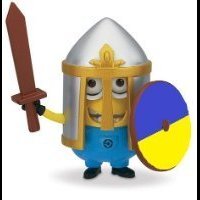

.thumb.jpg.0cb281983c298f55509ab7d9a06994bd.jpg)

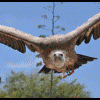
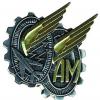
.thumb.jpg.cfc129272ffec824439b15e6013d5952.jpg)
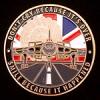
-1-1MINIATURA.thumb.jpg.bd7a7e672869500d45ee6e80478f6f25.jpg)
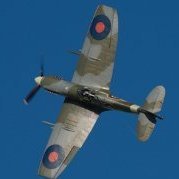

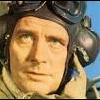
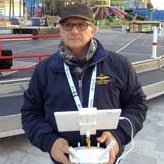
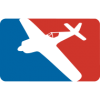

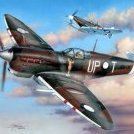



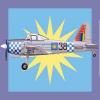


.thumb.jpg.158e2e086d45b8f96b7d93b8bee8dc21.jpg)



